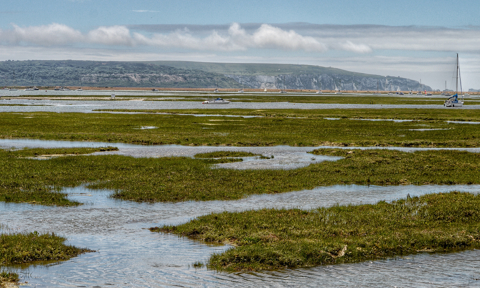Protecting our Marinas
Just like our marina users and berth holders, we love where we live/work. Considering ourselves lucky to run a marina where many choose to holiday, relax and spend their precious leisure time.
But we’re not the only ones here.

Yacht Havens Director Rupert Wagstaff explains “as custodians, we’re responsible for maintaining our marinas for the next generations, protecting and preserving our neighbouring wildlife’s habitats. Doing what we can to future proof our marinas for generations to come, so our berth holders can potter in and out of Lymington River, spot different species of wading birds, wild fowl, marine wildlife and enjoy the beautiful surroundings.”
But the rise in sea levels and rigours of natural waves has caused erosion along the coastline of Lymington’s salt marshes over the last century, impacting on Lymington harbour. And those salt marshes? Well, they play an important role in shielding our marinas, moorings and sea defences from wave attack too.
Rupert continued “something had to be done to protect the sustainability of the salt marshes, inhabiting wildlife and the future enjoyment of boating enthusiasts to come.”
In a pioneering scheme, dubbed a national trial for future regeneration projects, we joined forces with Lymington Harbour Commissioners (LHC) to work on significantly reducing marsh erosion through Beneficial Use of Dredged Material.
Have you spotted the barges out in the river and wondered who, what, why?
Well, it’s us, the Lymington Yacht Haven. (our neighbours at Berthon Boatyard have one out there too).
But what are Lymington Yacht Haven doing on barges?
We’re dredging lovely mud from the outer reaches of the Lymington riverbed and relocating it to the East side of the river, creating a sacrificial sediment-rich reef, to protect the salt marshes behind.
And we’ve been at it since 2014. Completing the first scheme in 2017, dredging 19,380 tonnes of mud, building an inter-tidal area at “Boiler Marsh”, which had previously suffered considerable erosion. In 2017, we were awarded a 5-year licence to undertake a second scheme, dredging 10,000 tonnes of mud every year until 2024.
As a member of the Solent Forum Beneficial Use of Dredging in the Solent (BUDS) project, it’s our duty to identify wider opportunities for beneficial use of dredged mud within the Solent too.

What’s dredging?
Using the Yacht Haven’s own dredging plant, digger and barge, our staff go out and dredge the outer reaches of Lymington River, taking it up along the East side, depositing it in a systematic order to build up the marsh level in designated areas. Take a look at dredging close up.
Why?
By creating a sacrificial reef within the bay; we can replenish the salt marsh, protect the marshes behind, encourage wildlife and slow down erosion.
The barge’s secret weapon is its hopper doors which open within the hull, without increasing the draft, which means we can deposit mud in very shallow water. Dropping denser, richer sediment for the benefit of populating wildlife.
When?
On this 5-year rolling programme, we’re out there dredging the river during November, December and January. Then we come back into the marina from mid-January through March to dredge the Lymington Yacht Haven marina to retain the depth of 2.5m below chart datum.
Is the dredging scheme encouraging wildlife to return?
We’re continually monitoring the effects and so far, careful monitoring has shown that much of the deposited sediment has consolidated, resulting in the newly built-up sites doing well. With marsh plants growing, wading birds feeding and wild fowl nesting along the coastline.
In summing up, Rupert added “together with the Lymington Harbour Commissioners we’re learning valuable lessons in how the technical aspects of this scheme can work alongside recreational leisure, ensuring the continued sustainable use of our beautiful Lymington harbour.”
We’ll report back soon on life on the saltmarshes, nesting wildlife and marina inhabitants.

